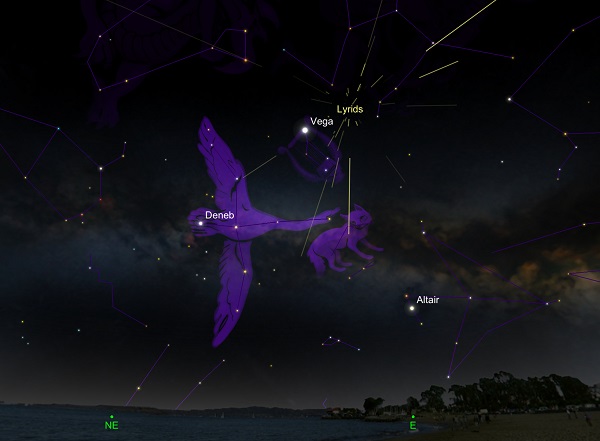April 20-23, 2017
Let's look up together for the Lyrid meteor shower!
The Lyrid meteor shower happens each year from about April 16 to 26 - however most meteors, also known as 'shooting stars' associated with this shower, appear on April 22. These streaks of light are mostly caused by sand grain-sized particles slamming into Earth's atmosphere at extreme speeds. The friction with the air causes the meteors to burn up in a fraction of a second. A shower occurs when Earth goes through a swarm of these particles in space which have been left behind by comets. As these icy visitors round the sun they begin to melt and shed material which gets deposited in stream that follows the same path as the comet itself. If you trace back the path of individual meteors part of a shower, they appear to come from one point in the sky known as the radiant, in this case in the constellation of Lyra (giving the annual event its name). You'll see the most Lyrid meteors near the shower's peak on April 22 as Earth moves through the debris left behind by Comet C/1861 G1 Thatcher, a regular visitor to the inner solar system referred to as a periodic comet. The recorded history of the Lyrids is longer than any other, with records of observations going back 2600 years.
Lyrid meteors are usually around magnitude +2, which is bright enough to be visible from most cities, but you'll see more and enjoy them more if you leave the city for a dark place where the stars shine brighter. They often produce luminous trains of dust that can be observed for several seconds. Some Lyrids will be larger and brighter, though, and the occasional "fireball" can cast shadows for a split second and leave behind glowing, smoky debris trails that last for minutes. Lyrid meteors disintegrate after hitting our atmosphere at a moderate speed of 29.8 miles per second but still produce amazingly bright streaks.
The Lyrid meteor shower is best seen across the Northern Hemisphere as its' radiant constellation, Lyra, the harp, rises above the northeastern horizon after local midnight.

During GAM we include a global Lyrids Watch when everyone is encouraged to observe the Lyrids and send in reports of what they saw. Observing reports like this are valuable scientific evidence that is gathered and analyzed by the International Meteor Organization (IMO). Submit your data to the IMO Visual Meteor Observation.
Tweet your data! You can also share your data by Tweeting your postcode, your country (click here to find your country code) and, optionally, the meteor count along with the hashtag; #MeteorWatch (you are welcome to use GAM hastags as well - #GAM2017 #LyridsWatch)
The meteor data will appear in a map at MeteorWatch.org
Resources:
EarthSky's meteor shower guide for 2013
Lyrids 2013 details at IMO
Visual Meteor Observation information at IMO
Share your Meteor experience with us:
Share your LyridsWatch images of outreach or meteor-photography with us via GAM Facebook or Twitter using #GAM2017 and #LyridsWatch (@gam_awb).
The Discover the COSMOS Challenge is a great opportunity, open to teachers, trainers, and students from all over the world. Read more.
Don't forget to login and register your event.








